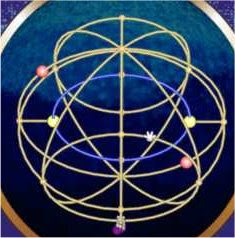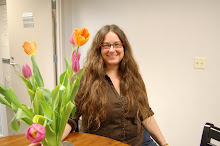Phillip Gerard, in How to Write a Book That Makes A Difference says building a novel is like building a cathedral. The main problems are to figure out 1) how to get it to stay up, and 2) how to make it have light.
"The problem is to build an architecture of light," he says.
He says both structures involve building an intricate scaffolding, which in the end is dismantled and no one sees.
And that you build a novel, like a cathedral, twice. The first time through is just to get a structure that stays up. The second time is to give it light. He says you cannot tell what your novel is, or how to give it light, until you have that first whole structure in place.
Saturday, September 22, 2007
Wednesday, September 19, 2007
making while teaching while studying

I love being in the center of three intersecting circles, where I am:
making the thing in one arena, whileIn 2001 I was:
teaching how to make it in another arena, while
studying how to make it in a third arena.
directing Medea, whileI was studying rehearsal, while rehearsing, while teaching how to rehearse. In these intensive-growth phases, I stop writing. I am changing so fast I can't monitor. I feel guyed and stayed, gyroscopically stable at the nexus of forces. I feel in my right place in the universe. In this state, I am the map. As soon as I see it, the light sparks and fissions through my interior map, instantly reforming it, and reforming me. This dissemination of light, reformation of the map & self, continues while I sleep.
teaching acting in my BCC class, while
studying directing in Bart Sher's Directing Lab.
In 2007:
I am making a game at MicrosoftMy unconscious is fed so much fantastic coherent stimulus, it's as if it were getting fed pure dream. It is incredibly, complexly efficient.
while teaching how to make games at DigiPen
while studying how to make games from Jason Mai and others
For one with eyes to read the subtext, Efreinov was right -- the best plays in the world take place in real life. Gorgeous, haunting, dripping, resonant, full-grown, feral, wide-awake humans in play. I hear the scenes and the subscenes while I am in them.Theatre is circles of Feeler-Actors: people who take action, and who feel, both kinesthetically and emotionally. Game-creation is circles of Thinker-Makers. People who think, and who make in the image of their thought.
Feeler-Actors understand layers of evocation. Thinker-Makers understand levels of abstraction. I am both. Innately, more of a Feeler-Mover, but enough of a Thinker-Maker to be addicted to insight and learning.
Thinking, feeling, touching, and moving are implementation-free. Theatre and games are nearly implementation-free; almost as light as it gets. Built from thought, movement, action, light, electricity, sand, plants, and water.
Eugenio Barba says every artist who goes far in his own practice, develops specific terms that are necessary for that practice, that arise from it, that precisely describe it -- and that these terms are often inscrutable to outsiders.To find the picture above, illustrating intersecting circles of game creation, I googled for "x,y,z, 3D". I didn't find anything, but it led me to a beautiful mindmap. I gave up on x,y,z and started researching mindmaps. Deep in the mindmaps, I stumbled across the perfect x,y,z illustration; it was a picture of a gamebox.
Synchronicity? Nexus of forces? Intersection.
perhaps my words, books,
insights from lean sages -- are
things all parents know
I think and feel, make
software games and theatre --
fluent, translating
integration is
a remorseless journey -- not
one thing can be saved
except the memory
of how to make a sword,
of the swordmaster
Saturday, September 15, 2007
Subscribe to:
Comments (Atom)
